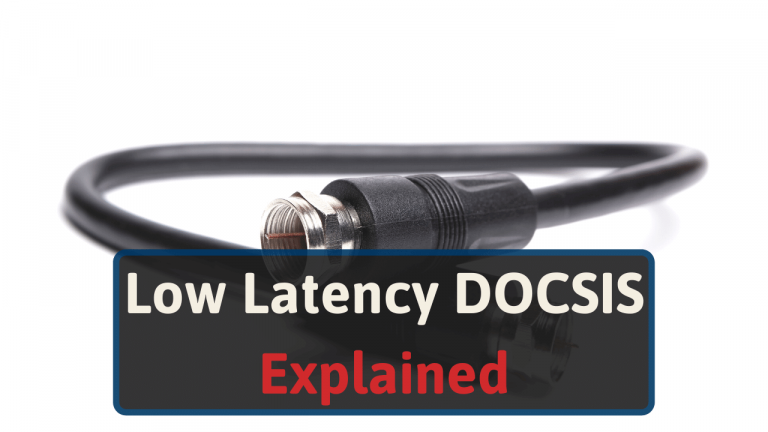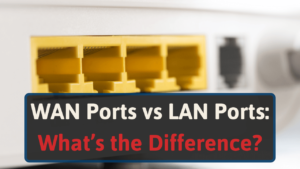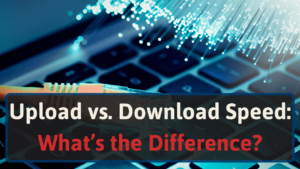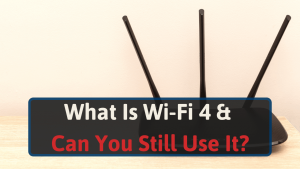I have read the CableLabs LLD whitepaper, so you don’t have to.
Continue reading to learn all about Low Latency DOCSIS and why you might want it.
Let’s jump in.
What is Low Latency DOCSIS?
Low Latency DOCSIS is a new technology that reduces latency on cable networks.
If you’re not familiar with latency, it is the time it takes for data to travel a network. An internet speed test can measure latency in milliseconds. [1]
CableLabs worked with several companies to develop low latency DOCSIS and released it in 2019. They designed LLD to targets the top two latency causes– media acquisition delay and queuing delay.
LLD uses a specific “fast lane” on an HFC network. It allows latency and jitter-sensitive applications to travel at fast speeds. This reduces the round-trip delay to 15 milliseconds or less.
LLD is now part of DOCSIS 3.1.
Why You Might Want Low Latency DOCSIS
Low Latency DOCSIS helps rank things that need quick turnaround time. For example, gaming or video calls. Using low latency DOCSIS provides better response times for those applications.
Here are the main benefits of low latency DOCSIS.
- Reduced “jitters” – Data travels to and returns from the server at fast speeds. “Jitters” are the delays that happen when your device sends data to the server. Reducing jitters can create an advantage for gamers, as there aren’t noticeable delays from the “lag” that jitters cause.
- Improved web browsing experience – Most people associate LLD with video streaming and gaming. You won’t have as much delay, giving you a more satisfying browsing experience.
- Better performance – LLD also benefits businesses using interactive cloud-based applications. As the name implies, it reduces latency surrounding these applications. That leads to more efficient work for the company.
Does DOCSIS 3.1 Improve Latency?
Yes, DOCSIS 3.1 improves latency, particularly from older versions, like DOCSIS 3.0. DOCSIS 3.1 helps reduce latency with active queue management. This is also one of the areas LLD targets.
Also, Low Latency DOCSIS is a new firmware feature of DOCSIS 3.1, which further improves latency.
What about DOCSIS 4.0?
Low latency is an integral feature of DOCSIS 4.0. It will be able to deliver low latency, as defined by CableLabs’ criteria of Low Latency DOCSIS:
- Able to reduce latency to under one millisecond
- Maintain latency speeds under five milliseconds on a busy and full network
DOCSIS 4.0 will be an excellent solution for latency issues. CableLabs released initial specs for the 4.0 upgrade in 2019.
Its main applications include situations that demand higher upstream speeds. This includes video conferencing, remote learning, virtual reality, and more. [2]
DOCSIS 4.0 devices aren’t currently available on the market. But they’re expected to release sometime in 2022.
How to Measure Latency
Latency measures the time it takes for data to reach its destination across the network. You calculate it as a round trip delay.
This is the time it takes for information to reach a server and return to your computer. You usually measure latency in milliseconds (ms).
You can measure latency yourself. To do so, run the command line in your operating system and do a Traceroute command.
For example, in Microsoft Windows, you would type in the command “tracert” at the command prompt.
Then follow up with the name of the destination. For example, you can use “aws.amazon.com,” “cloud.google.com,” or another site. [3]
Then, you’ll see the screen responses for each router along the pathway to the particular website. A time measurement in milliseconds accompanies the data. Add both times in milliseconds to get your latency.
Or, you could use network management tools. IT professionals in corporate networks use these. Or you can use the simple speed test on Google.
Type “speed test” into Google Search and click “Run Speed Test.” The test will provide your upload and download speed along with your latency.
Why it is Important to Keep Latency Low
Low latency is critical for the best online experience. Fast upload and download speed isn’t everything. Yet, speed and latency relate and are essential for network performance. But, they are different metrics.
For instance, high speeds are ideal, as it allows the streaming of a 4K video. High speed is excellent for this, and latency doesn’t matter much.
But, consider a trendy online multiplayer game. The dynamic game demands high speeds. On average, data packets send at a bitrate of 100 kbps to 200 kbps.
Yet, given that you interact with other players live, latency is more critical than speed. Things happen fast in video games.
This demands instantaneous reactions. A minor millisecond delay can be the defining factor of winning or losing.
If you have poor latency, you will experience lag in online multiplayer video games.
With lower latency, players can have a quicker reaction time. This will make the game more fun and fair. But the advantages of low latency extend beyond gaming.
For example, it affects finance and day trading, giving participants a competitive edge. This allows them to make fast trades and make a higher profit.
How Low Latency DOCSIS Reduces Latency
Low Latency DOCSIS targets latency issues by isolating the significant sources for latency. The main culprits are queuing and media acquisition.
Queuing delay is the primary source of latency. Most applications rely on TCP and mirroring protocols. This helps get as much bandwidth as possible.
Algorithms then adjust to the link, which is the speed. These algorithms work to avoid congestion. This, in turn, stresses buffers and queues, increasing latency.
Low Latency DOCSIS uses a dual queuing approach to resolve this issue. Let’s consider applications that aren’t queue building, like online gaming. These applications use a different queue than the traditional path.
So, non-queue building traffic uses smaller buffers, which minimizes the latency. At the same time, queue-building traffic uses larger buffers. This maximizes the throughput.
The other top cause of latency issues is media acquisition delays.
This is due to a scheduling mechanism on a joint medium, such as a coax cable. Consider the scheduling mechanisms.
These make sure a single user employs a transmission slot at a given time. Generally, this adds an extra 2 to 8 ms round trip time.
LLD corrects this issue using DOCSIS MAP intervals. Additionally, it uses Pro-active Grant Services (PGS) to help. PGS enables the modem to send upstream traffic without requesting it.
Other Latency Causes
The causes of latency involve both inherent and component factors. Both contribute to latency; here are some common causes:
Component Causes
Many people assume the network is the sole cause of latency. This is incorrect. Many devices hardware devices cause latency too.
For instance, consider gaming. The gaming console itself introduces latency. Or, when your device creates an image, there is latency. It is a 16 to 33 ms delay before reaching the screen with an HDMI connection.
Also, your brain has latency. Messages travel to our brain from our senses of sight and sound. This takes time to travel. Unfortunately, you can’t reduce this type of latency.
Inherent Causes
There are inherent causes of latency on a network that we can’t do much about either. A few of these causes include:
- Geographical distance
- Queuing and buffering
- Deserialization and serialization
- Propagation delay
Low Latency Advantages
Low Latency DOCSIS offers several advantages. A few of these helpful features include:
- Active queue management algorithms: As queues accumulate, it drops packets to keep a target latency. Basically, it moves data to the front of the line that is more important to reduce latency. [4]
So, the low-latency service flow utilizes a new AQM algorithm (Immediate AQM). It doesn’t drop packets like the DOCSIS PIE algorithm.
Instead, it notes the ECN field in the IP header. This uses Congestion Experienced bits to guarantee a shallow queue.
The two algorithms combine probabilities. It ensures bandwidth capacity is a shared feature with both service flows in the Aggregate Service Flow.
- Service flow traffic classification: This feature assists with packet classification. This is critical for placing a particular packet into the appropriate flow. Whether classic or low-latency service.
- Queue protection: This aspect of low latency assists by categorizing packs. It organizes them into application data flows. Which are Microflows. It helps ensure that every microflow goes to the applicable service flow. This depends on two factors: network traffic type and critical latency threshold.
- Type of Proactive Granite Service scheduling. Another plus of LLD is its data scheduling. It uses PGS to make a quicker request grant cycle by omitting the need for a bandwidth request. Basically, it orders data in an efficient way to reduce latency.
- ASF service flow encapsulation: It uses an Aggregate Maximum Sustained Rate (ASMR). And LLD’s ASF handles the traffic shaping of both service flows. The ASMR is the total combination of the low latency and classic service bit flow rates.
Conclusion
Low Latency DOCSIS can revolutionize the online experience. It helps with demanding gaming and video conferences.
There are a few inherent, unavoidable latency causes. But LLD does improve avoidable causes. Minimizing latency creates an all-around more positive online experience. It could impact industries worldwide.
Check out our guide on latency and bandwidth to learn more.







